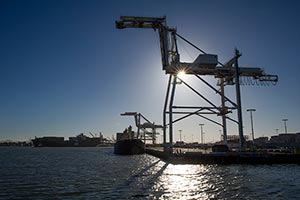What to Do With Empty Terminals in Oakland? Nothing, Port Says

The half-dozen giant cranes that once lifted huge containers of goods on 160 acres of East Bay waterfront now lie dormant.
And the Port of Oakland is pretty OK with that. In fact, the agency, which also operates Oakland International Airport, seems almost eager to not do anything with the vast tract of essentially vacant land.
On the surface, this attitude might seem odd — even flippant. A busy port usually indicates robust economic activity. A partially empty port means millions of dollars in lease payments not flowing into the Port of Oakland’s coffers. And sitting on unused waterfront property is practically sacrilegious in this era of sky-high real estate prices.
But waiting it out actually makes sense, given the glut in the global shipping industry and the agency’s efforts to turn the sixth-largest port in the United States into more of an export powerhouse. Goods like wood pulp, fruit and steel flow to Asia from the port, and officials hope to expand that business significantly.
“We’re all for growth, but growth in a responsible way,” Port of Oakland executive director Christopher Lytle said.
RELATED: Port of Oakland Sees Upside in Losing Giant Tenant
The past couple of years have been trying for Lytle. Though the agency’s maritime division (as distinct from the airport) saw overall revenue rise last year, the number of shipping containers entering and leaving the port dropped 6.5% to 1.71 million from 1.83 million in 2014, according to port figures.
The drop-off was due in part to the nine-month contract dispute between shippers and a union representing longshoremen that resulted in severe slowdown at ports across the West Coast, including Oakland, Long Beach, Seattle and San Diego.
And in February, disaster struck: Ports America Outer Harbor Terminal, Port of Oakland’s second largest tenant, filed for Chapter 11 bankruptcy protection. Just five years ago, Ports America and the agency had signed a 50-year lease agreement, making the Port of Oakland the company’s single largest unsecured creditor, according to documents filed with U.S. Bankruptcy Court in Delaware.
After Ports America departed, the Port of Oakland was left with a swatch of prime waterfront real estate that commercial and residential developers and industrial firms can only dream of. But after some contemplation, the agency decided to play the long game, and not even lease it to another terminal company.
For one thing, there was a reason why Ports America went bankrupt. The shipping business is in the doldrums. That’s thanks partly to the advent of large numbers of megaships, which have sent prices down as they carry more cargo per trip and reduce fuel costs. That’s good news for consumers, since the vast majority of the world’s goods travel by sea. But it wreaks havoc on port-related companies, which are losing money trying to gain market share by cutting prices.
Before its bankruptcy, Ports America was losing about $40 million a year. With the industry stagnating, the company was cutting rates and thus taking business away from the Port of Oakland’s other terminal operators, including TraPac and Evergreen, Lytle said.
Signing up someone to replace Ports America will only repeat the same mistake, he said.
“You’ve got this vacant land,” Lytle said. “What’s the right thing to do? Should we go out and fill the space right away with another operator? What happens at a lot of U.S. ports is that they end up with overcapacity. If we put another terminal operator over here, which we would find without a problem, where will they get their business?”
The agency has been able to shift Ports America’s customers to other terminal operators throughout the area, so it’s not as if the Port of Oakland has lost business.
But the temptation to do something with the land must be very strong. Colliers International, a commercial real estate firm, estimates the vacancy rate for the Interstate 80/880 corridor industrial market was a tight 2.1% in the first quarter this year compared with 3.9% during the period a year ago.
Lytle, however, wants to stay put. The port estimates that container traffic will grow 3% or more annually over the next few years, and he anticipates that the industry will stabilize and the terminals will “fill to the right levels” over the next decade or so. That could be helped by a wave of mergers and acquisitions, which Drewry, a British shipping consulting firm, predicts will sweep across the industry. (We’re also likely to see more terminal operators follow Ports America into bankruptcy.)
The Port of Oakland is an ideal export location because ships from Asia normally visit Southern California to drop off cargo before heading north to places like Oakland and Seattle to receive American exports.
And when there are more exports, the now-vacant land will again be valuable. It’s right next to where the Port of Oakland plans to convert a former U.S. Army base into a logistics center (port officials just signed a $550 million agreement with CenterPoint Properties to do the conversion). The facility can transfer food from places like St. Louis, Chicago and Memphis, Tennessee, directly from trains to ships for exports without needing trucks.
Unlike the import-heavy Port of Long Beach, which Lytle previously oversaw, he wants to preserve an equal balance of exports and imports in Oakland. That’s why he’s is not anxious to do anything that will upset the delicate business of the agency’s existing tenants.
“People are clamoring for land close to the port,” he said. “We can make a decent amount of money from short-term uses like truck parking. But our board doesn’t want us to make the same mistakes that were made a few years ago, putting someone in there that couldn’t get business. If a company doesn’t have a good plan that’s going to say where the cargo is coming from, why we would do that?”

